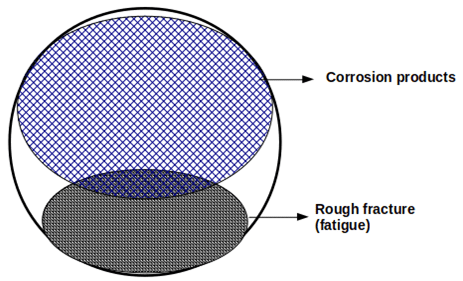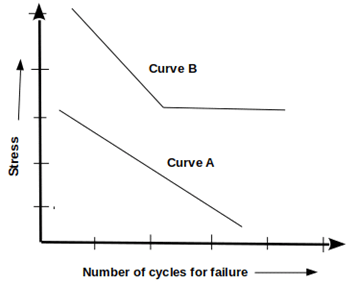This set of Corrosion Engineering Multiple Choice Questions & Answers (MCQs) focuses on “Eight Forms – Corrosion Fatigue”.
1. Corrosion fatigue is defined as the reduction of fatigue resistance due to the presence of a corrosive medium.
a) True
b) False
View Answer
Explanation: Corrosion fatigue is a simultaneous action of corrosion and fatigue on a metal. It is defined as the reduction in fatigue resistance due to the presence of a corrosive medium.
2. What is meant by fatigue?
a) The tendency of a metal to fracture under static loading
b) The tendency of a metal to fracture under repeated cyclic loading
c) The tendency of a metal to fracture under non-repeating cyclic loading
d) The tendency of a metal to fracture after heavy deformation
View Answer
Explanation: Fatigue is defined as the tendency of a metal to fracture under repeated cyclic loading. Bridges, machines will usually fail due to fatigue. It fails the metals even below the yield stress of that metal due to repeated cyclic loading.
3. What is the nature of fatigue fracture?
a) Brittle fracture
b) Cup and cone fracture
c) Tensile fracture
d) Brittle and tensile fracture
View Answer
Explanation: A fatigue crack propagates until the cross-sectional area of the metal is reduced to the point where the ultimate strength is exceeded and rapid brittle fracture occurs. The nature of fatigue fracture is brittle.
4. Which of the following type of corrosion is depicted in the given figure?

a) Cavitation damage
b) Fretting corrosion
c) Corrosion fatigue
d) Uniform corrosion
View Answer
Explanation: Corrosion fatigue is defined as the simultaneous effect of corrosion and fatigue on a metal. A fatigue crack propagates until the cross-sectional area of the metal is reduced to the point where the ultimate strength is exceeded and rapid brittle fracture occurs. And the other part experience corrosion.
5. Define the fatigue limit of a metal.
a) Stress below which metal will endure an infinite number of cycles without fracture
b) Stress above which metal will endure an infinite number of cycles without fracture
c) Stress at which metal will endure a less finite number of cycles
d) Stress at which metal will endure a more finite number of cycles
View Answer
Explanation: Fatigue limit is the stress below which metal will endure an infinite number of cycles without fracture. The fatigue limit can be calculated by (SN curve) stress and the number of cycles curve.
6. Which of the following metal is depicted by curve A of given SN graph?

a) Aluminum
b) Tungsten
c) Steel
d) Calcium
View Answer
Explanation: The given figure is an SN curve with the stress of the y-axis and the number of cycles on the x-axis. Curve A depicts the SN curve of nonferrous metals such as aluminum, copper, and nickel. Fatigue resistance for these metals increases with decreases in stress applied.
7. Which of the following metal is depicted in curve B of a given SN graph?

a) Aluminum
b) Copper
c) Steel
d) Zinc
View Answer
Explanation: Ferrous alloys exhibit an increase in fatigue resistance with a decrease in stress, after that, it remains independent of stress applied. This point is known as the fatigue limit of the metal. It is defined as the stress below which the metal will endure an infinite number of cycles without fracture.
8. Which of the following is/are the factors that influence corrosion fatigue?
a) Type of metal
b) Composition of corrosive solution
c) Temperature
d) Type of metal, corrosive solution composition, and temperature
View Answer
Explanation: The factors that influence corrosion fatigue:
• Type of metal (FCC, BCC, HCP)
• Composition of corrosive solution
• Temperature
• PH of the environment
• Percentage of oxygen content.
9. Which of the following is/are the facts that indicate the reduction in fatigue resistance of metal?
a) Corrosion pits act as stress raisers
b) Corrosion pits act as initiate cracks
c) Corrosion pits act as a stress raiser and initiate cracks
d) Corrosion pits neither act as stress raiser nor initiate cracks
View Answer
Explanation: Corrosion fatigue is the combination of both corrosion and fatigue simultaneously. Fatigue resistance is reduced because corrosion pits act as stress raisers and initiate cracks.
10. Which of the following is/are the preventions of corrosion fatigue?
a) Use of high tensile strength metals
b) Perform shot penning to induce compressive stresses
c) Use coatings such as electrodeposited zinc, nickel
d) Use of high tensile strength metals, perform shot penning to induce compressive stresses and use of coatings such as electrodeposited zinc, nickel
View Answer
Explanation: Methods to prevent corrosion fatigue:
• Use of high tensile strength metals
• Perform shot penning to induce compressive stresses
• Use coatings such as electrodeposited zinc, nickel, chromium, copper and nitride coatings.
Sanfoundry Global Education & Learning Series – Corrosion Engineering.
To practice all areas of Corrosion Engineering, here is complete set of 1000+ Multiple Choice Questions and Answers.
If you find a mistake in question / option / answer, kindly take a screenshot and email to [email protected]
- Practice Metallurgical Engineering MCQs
- Check Corrosion Engineering Books
- Check Mechanical Engineering Books
- Practice Mechanical Engineering MCQs
- Apply for Mechanical Engineering Internship
